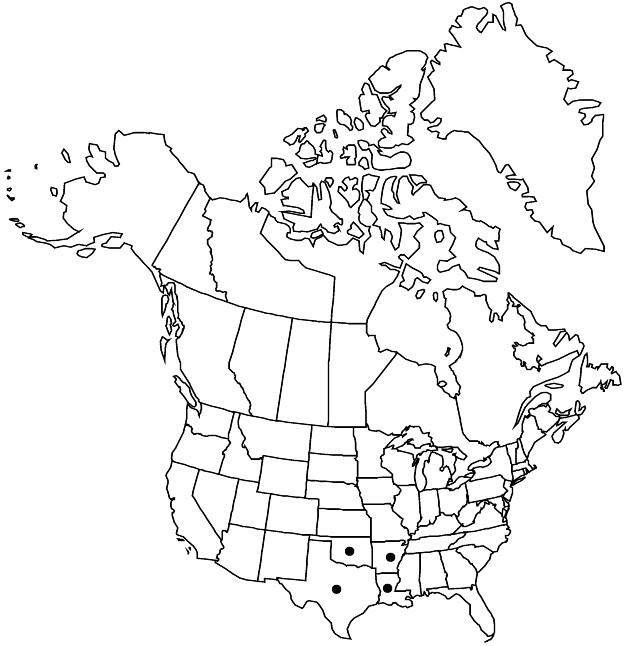Difference between revisions of "Minuartia drummondii"
Notes Roy. Bot. Gard. Edinburgh 24: 147. 1962.
FNA>Volume Importer |
imported>Volume Importer |
||
| (6 intermediate revisions by 2 users not shown) | |||
| Line 8: | Line 8: | ||
}} | }} | ||
|common_names=Drummond’s stitchwort | |common_names=Drummond’s stitchwort | ||
| − | |basionyms={{Treatment/ID/ | + | |special_status={{Treatment/ID/Special_status |
| + | |code=E | ||
| + | |label=Endemic | ||
| + | }} | ||
| + | |basionyms={{Treatment/ID/Basionym | ||
|name=Arenaria drummondii | |name=Arenaria drummondii | ||
|authority=Shinners | |authority=Shinners | ||
| + | |rank=species | ||
| + | |publication_title=Field & Lab. | ||
| + | |publication_place=17: 89. 1949, | ||
}} | }} | ||
|synonyms= | |synonyms= | ||
| Line 27: | Line 34: | ||
|elevation=0-500 m | |elevation=0-500 m | ||
|distribution=Ark.;La.;Okla.;Tex. | |distribution=Ark.;La.;Okla.;Tex. | ||
| − | |discussion=<p>Minuartia drummondii is easily recognized by the proportionally large corollas (petals to three times as long as sepals) and pedicels reflexing in fruit.</p> | + | |discussion=<p><i>Minuartia drummondii</i> is easily recognized by the proportionally large corollas (petals to three times as long as sepals) and pedicels reflexing in fruit.</p> |
|tables= | |tables= | ||
|references= | |references= | ||
| Line 36: | Line 43: | ||
-->{{#Taxon: | -->{{#Taxon: | ||
name=Minuartia drummondii | name=Minuartia drummondii | ||
| − | |||
|authority=(Shinners) McNeill | |authority=(Shinners) McNeill | ||
|rank=species | |rank=species | ||
| Line 50: | Line 56: | ||
|publication title=Notes Roy. Bot. Gard. Edinburgh | |publication title=Notes Roy. Bot. Gard. Edinburgh | ||
|publication year=1962 | |publication year=1962 | ||
| − | |special status= | + | |special status=Endemic |
| − | |source xml=https:// | + | |source xml=https://bitbucket.org/aafc-mbb/fna-data-curation/src/2e0870ddd59836b60bcf96646a41e87ea5a5943a/coarse_grained_fna_xml/V5/V5_253.xml |
|subfamily=Caryophyllaceae subfam. Alsinoideae | |subfamily=Caryophyllaceae subfam. Alsinoideae | ||
|genus=Minuartia | |genus=Minuartia | ||
Latest revision as of 22:09, 5 November 2020
Plants annual. Taproots filiform. Stems erect to ascending, green, 5–20 cm, stipitate-glandular, often densely so, internodes of all stems 1–3 times as long as leaves. Leaves overlapping proximally, perfoliate proximally, with ± loose, scarious to herbaceous sheath 0.5–1 mm; blade green, flat, 1-veined, oblanceolate to cuneate (proximal) to oblong-lanceolate to ovate (remaining cauline), 5–30(–35) × 2–4 mm, flexuous, margins not thickened, ± scarious, smooth, apex green to purple, obtuse to abruptly pointed, dull, glabrous; axillary leaves absent. Inflorescences 7–12-flowered, open cymes, or rarely solitary, terminal; bracts ± lanceolate, herbaceous, sometimes scarious-margined proximally. Pedicels reflexed in fruit, 0.5–2.5 cm, stipitate-glandular. Flowers: hypanthium disc-shaped; sepals obscurely veined, ovate to broadly elliptic (herbaceous portion ovate to broadly elliptic), 3–6 mm, to 7 mm in fruit, apex green or purple, acute to acuminate, not hooded, stipitate-glandular; petals obovate to oblanceolate, 2–2.5 times as long as sepals, apex rounded, broadly notched. Capsules sessile, broadly ellipsoid, 6–7.5 mm, equaling or longer than sepals. Seeds dark brown to blackish, orbiculate with radicle prolonged into beak, only slightly compressed, 0.7–0.8 mm, echinate with rounded tubercles.
Phenology: Flowering late winter–early summer.
Habitat: Open grassy woodlands, sandy soils
Elevation: 0-500 m
Distribution

Ark., La., Okla., Tex.
Discussion
Minuartia drummondii is easily recognized by the proportionally large corollas (petals to three times as long as sepals) and pedicels reflexing in fruit.
Selected References
None.